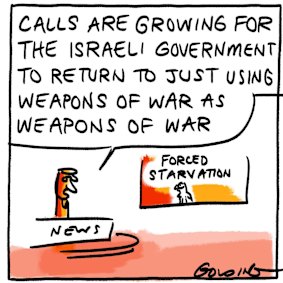- Graphic content
- Politics
- Federal
- Israeli-Palestinian conflict
‘Innocent life matters’: The photographs of children that captured the world’s conscience
By Nick Newling
Warning: Graphic content
The photograph of an emaciated child broke Prime Minister Anthony Albanese’s heart.
“For anyone with any sense of humanity, you have to be moved by that, and you have to acknowledge that every innocent life matters, whether it be Israeli or Palestinian,” Albanese said.
“A one-year-old boy is not a Hamas fighter, and the civilian casualties and death in Gaza is completely unacceptable,” he told ABC’s Insiders on Sunday. “That boy isn’t challenging Israel’s right to existence, and nor are the many who continue to suffer from the unavailability of food and water.”
The image of Muhammad Zakariya Ayyoub al-Matouq being cradled by his mother Hedaya al-Muta’wi, captured on July 21 and distributed by the photographic network Getty, evoked previous pictures that shocked the world.
There is the photograph of Phan Thi Kim Phuc running from a napalm attack in 1972 during the Vietnam War, Steve McCurry’s portrait of Afghan refugee Sharbat Gula in 1984, and a haunting image of a vulture stalking a Sudanese child amid widespread famine in 1993.
In each case, the ethics behind the photograph have become disputed. Was the image exploitative? Should the photographer have intervened? What toll did it take on the individual who became a symbol for wider suffering?
The Israeli embassy in Australia went further on Monday. Deputy head of mission, Amir Meron, told journalists that there was no starvation in Gaza and that “false pictures” of the situation in the territory were spreading.
“This is a false campaign that is being [led] by Hamas, taking advantage of sick children in order to show a false claim and false presentation of hunger and starvation in the Gaza strip,” Meron said, without specifically referring to the image of al-Matouq.
Unverified reports that al-Matouq had various pre-existing conditions, including cerebral palsy, have been circulating online.

Credit: Matt Golding
But his mother, Al-Muta’wi, said that hunger had caused her son to develop hypertonia – a stiffening of the muscles which limits movement – and he was no longer able to sit or stand due to fatigue.
“He today weighs six kilograms, he wasn’t like that before, he weighed nine kilograms and used to eat and drink normally, but because of lack of food and the situation we are in, he became malnourished. He is suffering from severe malnutrition,” al-Muta’wi told the BBC.
The photographer who captured the image, Ahmed al-Arini, told the BBC that he took the image to “show the rest of the world the extreme hunger that babies and children are suffering from in the Gaza strip”.
He said that Muhammad had not received milk, formula or vitamins and was living in a canvas tent with his mother after fleeing their home in the north.
The World Health Organisation reported on Sunday that malnutrition rates are reaching “alarming levels” in Gaza. It found that of the 74 malnutrition-related deaths reported in 2025, 63 had occurred this month, including 25 children.
Albanese said on Sunday that the Israeli government had “quite clearly” breached international law in its provision of humanitarian aid, calling death in Gaza “completely indefensible”.
Dr Andrea Baker, a senior lecturer in photojournalism at Monash University, said the phrase “a picture says a thousand words” applied to conflict photography.
The Terror of War, colloquially known as Napalm Girl, helped shift public opinion in the US against the Vietnam War by showing the brutality of a South Vietnamese napalm strike that inadvertently hit its own side in 1972.
Nick Ut, a South Vietnamese photographer who was working for the Associated Press, helped get the child to safety, though his claim to have taken the photo has since been contested.
Its subject, Phan Thi Kim Phuc, initially felt ashamed of the image but came to use it as a platform to advocate for humanitarianism.
American photographer Steve McCurry’s National Geographic cover image Afghan Girl defined the Soviet–Afghan War for many Western readers. However, the subject of the photo, Sharbat Gula, decades later told Italian newspaper La Repubblica she wished the image had not been taken and that it was culturally insensitive.
A 1993 image by South African photojournalist Kevin Carter, depicting a starving Sudanese child being stalked by a vulture, captured the plight of the famine-ravaged country.
It also launched a debate on the ethical responsibilities of photographers who can help the subjects of their images. Carter told the New York Times he had chased away the vulture and the child had resumed walking to a fate unknown.
Locals later told Spanish media that the child, Kong Nyong, had survived the conflict but died in 2007.
The photographer won a Pulitzer Prize for the image in 1994, but died by suicide several months later.
Another image, of three-year-old Syrian refugee Aylan Kurdi lying face down on a beach in Turkey after drowning in the Mediterranean Sea, was a turning point in the debate around the Syrian refugee crisis of the 2010s.
Baker said that being in an image of conflict was a particularly “emotive experience” and photojournalists had to consider whether the publication of a photo was in the public interest.
“Does this really impact the whole story? Does it really tell the story from a clear, objective and authentic point of view? That’s where we have to tie into that code of ethics.”
Bearing witness, she said, was the critical role of photojournalism.
“People don’t really, I’d say, believe it until they see it.”
Cut through the noise of federal politics with news, views and expert analysis. Subscribers can sign up to our weekly Inside Politics newsletter.